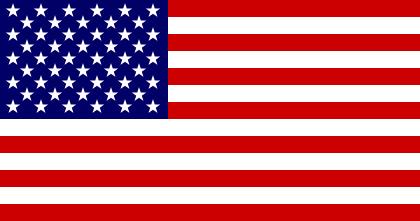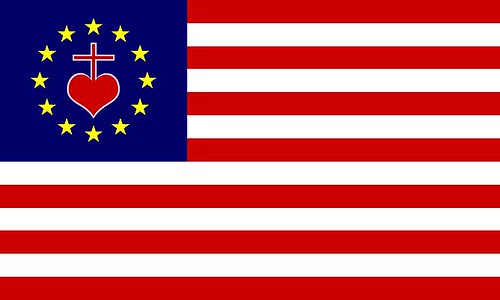
This flag image is from the excellent vexillogical website Flags of the World. Vexillogy is the study of flags, and Catholics ought to be reminded of the Latin hymn Vexilla Regis, for a use of that Latin word.
The description and use of the flag is put forth in the United States Code, Title 4, Chapter 1. From the code:
§ 6. Time and occasions for displayFlag etiquette is sometimes ignored these days. So for edification, here is the relevant section:
(a) It is the universal custom to display the flag only from sunrise to sunset on buildings and on stationary flagstaffs in the open. However, when a patriotic effect is desired, the flag may be displayed 24 hours a day if properly illuminated during the hours of darkness.
(b) The flag should be hoisted briskly and lowered ceremoniously.
(c) The flag should not be displayed on days when the weather is inclement, except when an all weather flag is displayed.
(d) The flag should be displayed on all days, especially on New Year’s Day, January 1; Inauguration Day, January 20; Martin Luther King Jr.’s birthday, third Monday in January; Lincoln’s Birthday, February 12; Washington’s Birthday, third Monday in February; Easter Sunday (variable); Mother’s Day, second Sunday in May; Armed Forces Day, third Saturday in May; Memorial Day (half-staff until noon), the last Monday in May; Flag Day, June 14; Father’s Day, third Sunday in June; Independence Day, July 4; National Korean War Veterans Armistice Day, July 27; Labor Day, first Monday in September; Constitution Day, September 17; Columbus Day, second Monday in October; Navy Day, October 27; Veterans Day, November 11; Thanksgiving Day, fourth Thursday in November; Christmas Day, December 25; and such other days as may be proclaimed by the President of the United States; the birthdays of States (date of admission); and on State holidays.
(e) The flag should be displayed daily on or near the main administration building of every public institution.
(f) The flag should be displayed in or near every polling place on election days.
(g) The flag should be displayed during school days in or near every schoolhouse.
§ 8. Respect for flagIt parades, it is often international custom for a flag bearer to dip his flag in honor, towards the dignitary host of the event. The United States forbids this. The statement “this flag dips to no earthly king” is attributed to the flag bearer at the 1908 London Olympics.
No disrespect should be shown to the flag of the United States of America; the flag should not be dipped to any person or thing. Regimental colors, State flags, and organization or institutional flags are to be dipped as a mark of honor.
(a) The flag should never be displayed with the union down, except as a signal of dire distress in instances of extreme danger to life or property.
(b) The flag should never touch anything beneath it, such as the ground, the floor, water, or merchandise.
(c) The flag should never be carried flat or horizontally, but always aloft and free.
(d) The flag should never be used as wearing apparel, bedding, or drapery. It should never be festooned, drawn back, nor up, in folds, but always allowed to fall free. Bunting of blue, white, and red, always arranged with the blue above, the white in the middle, and the red below, should be used for covering a speaker’s desk, draping the front of the platform, and for decoration in general.
(e) The flag should never be fastened, displayed, used, or stored in such a manner as to permit it to be easily torn, soiled, or damaged in any way.
(f) The flag should never be used as a covering for a ceiling.
(g) The flag should never have placed upon it, nor on any part of it, nor attached to it any mark, insignia, letter, word, figure, design, picture, or drawing of any nature.
(h) The flag should never be used as a receptacle for receiving, holding, carrying, or delivering anything.
(i) The flag should never be used for advertising purposes in any manner whatsoever. It should not be embroidered on such articles as cushions or handkerchiefs and the like, printed or otherwise impressed on paper napkins or boxes or anything that is designed for temporary use and discard. Advertising signs should not be fastened to a staff or halyard from which the flag is flown.
(j) No part of the flag should ever be used as a costume or athletic uniform. However, a flag patch may be affixed to the uniform of military personnel, firemen, policemen, and members of patriotic organizations. The flag represents a living country and is itself considered a living thing. Therefore, the lapel flag pin being a replica, should be worn on the left lapel near the heart.
(k) The flag, when it is in such condition that it is no longer a fitting emblem for display, should be destroyed in a dignified way, preferably by burning.
The flag is not humiliated towards any earthly king, but an exception is made towards Christ the King. Church flags take precedence. This is an obvious sign of humility in governance. Earthly power comes and goes, for it is a passing thing, easily taken away as it is given. As the Declaration of Independence states, the nation is bound absolutely to follow the “Laws of Nature and of Nature's God”. This concept was taken from the sole Catholic Founding Father of the Republic, Charles Carroll; the other Founders had placed their hopes in the worldly institution of Puritan Parliament, and that institution failed them. Rather, only a government in harmony with the laws of human nature has a chance of success.
For my own contribution to vexillogy, I offer this following design of a patriotic banner for American Catholics:

Not a replacement for the Flag of the Republic, this perhaps could be used as a minor symbol by patriotic Catholics who wish to both proclaim allegiance to the Republic while also being explicitly Catholic.
It is based on what is called the Betsy Ross flag, and has squarer proportions than the official flag of the United States of America, so as to make larger the canton, or upper left blue rectangular area. It includes the traditional thirteen horizontal red and white stripes used in the American flag, symbolizing the thirteen colonies which declared their independence from Britain.
The five-pointed stars are arranged in a circular pattern, also reminiscent of the Betsy Ross Flag. This pattern was actually taken from the flag of the European Union, with its gold stars, but with the darker Navy Blue color used in the American Flag. That I used the European Union flag as the exemplar does not mean that this flag is the daughter of that banner, but rather is her sister: for the EU banner was explicitly modeled after the Betsy Ross canton.
Although the EU flag is derived from the early American flag, there are twelve, rather than thirteen stars. The EU thought 13 to be an inauspicious number, while the number twelve has many positive connotations, such as the 12 hours of daylight, 12 months in a year, 12 constellations in the zodiac, the Twelve Tables of the Roman Law, the 12 tribes of Israel, and the 12 Apostles. It also represents the first 12 founding nations of the EU. However, the designer most specifically took this from Revelation 12:1, “A great sign appeared in the sky, a woman clothed with the sun, with the moon under her feet, and on her head a crown of twelve stars.” Therefore I use twelve stars, making this a symbol of the Blessed Virgin Mary as our Queen Mother, and of the Church.
I retained the use of five pointed stars out of tradition, although perhaps a six-pointed star, the Star of Creation, is better suited for this task; even some early American flags used six-pointed stars. Five-pointed stars have mixed symbolism, both positive and negative, amenable or hostile to the principles of the Republic, and so this type of symbol confusion is inevitable when a symbol is too simple and therefore too common. But for our purposes, this five pointed star is an ancient symbol of the Morningstar, and the planet Venus seen in the morning is in itself an ancient symbol of the Blessed Virgin Mary.
In the center of the stars is a very simple representation of the Sacred Heart of Jesus, surmounted by a cross, making this an explicitly Christian symbol to even casual observers who may not be familiar with Catholic symbolism. The devotion to the Sacred Heart, we must remember, is devotion to God's wounded love for us: we are the unfaithful spouse of a great King. The heart symbolizes God's love, and the cross symbolizes God's suffering. This is most specifically the Sacred Heart of the Vendée, and so is a symbol of religious liberty and a sign against tyranny. I got this idea from a flag used by patriotic French Catholics. That the symbol of Jesus in within the symbol of Mary here ought to remind us of the Incarnation.
In the Catholic Church, June is dedicated to the Sacred Heart, and in the United States, June is a very patriotic month, second only to July, so I thought this particular project seemed appropriate at this time.
The colors are also symbolic, with red representing blood and therefore the moral virtue of courage; white represents purity and therefore the moral virtue of temperance and ought to remind us of the use of white in the Te Deum; navy blue represents the moral virtues of prudence and justice, and it also represents Heaven. The gold of the stars represents the Divine light, the theological virtues of Faith, Hope, and Charity, the nobility of the Church, and wisdom.


OK, I'm going to ask it. How much of this borders on idolatry? I'm thinking especially of the term "flag desecration." Can you really desecrate a flag? Am I being too picky here? But some of these rules of etiquette make it sound like the flag is a sacramental.
ReplyDeleteBTW, I did make sure mine was raised briskly this morning!
Well, what do you expect from a government formed by apostates? I understand that for about 100 years, no American President would take communion when attending church services: at least they were honest about their heresy, unlike lots of contemporary politicians.
ReplyDelete